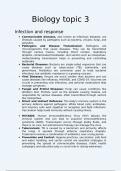Summary
GCSE Biology infection and response summary ( AQA)
These GCSE Biology notes provide comprehensive coverage of the topic of infection and response. You'll learn all about the defence mechanisms of the immune system, from the skin's physical barriers to the production of antibodies. The notes also cover the role of vaccination in preventing the sprea...
[Show more]



